
Wine Culture and Information since 2002 - Volume 22
 Wine Culture and Information since 2002 - Volume 22 |
|
Comparing Primitivo and NegroamaroAmong the grapes and wines of Apulia, Primitivo and Negroamaro undeniably are the most famous expressions of the region, capable of making wines of character and structure |
|
Apulia is among the Italian regions having the highest production in terms of quantity. For years the grapes produced in the vineyards of this region took their way to Northern Italy - as well as to abroad - in order to give body to those wines which were not so rich in structure, in particular Primitivo and Negroamaro grapes. The climate of this region - among the sunniest in Italy - gives grape a pretty high quantity of sugar and if in other regions the reaching of full ripeness is sometimes a problem, in Apulia it hardly is. The excessive ripeness and the excessive action of sun rays can sometimes give wines of Apulia mature aromas and flavors, frequently recalling fruit jams, a characteristic frequently happening in very hot vintages. Primitivo and Negroamaro are no exception in this, however with scrupulous viticultural and wine making techniques, these two grapes are capable of making wines of great personality and quality.
|
Primitivo has been the first grape of Apulia to go outside the borders of the region and to give notoriety to the wines of this area. For years it has been discussed about the origin of this renowned red berried grape. Many researches have allowed a better knowledge of Primitivo grape as well as discovering other varieties with genetic characteristic equal to the famous Apulian red, including Zinfandel, name with which Primitivo is known in the United States of America. These studies have also revealed the red variety Crljenak Kaštelanski cultivated in Croatia is genetically analog to Primitivo. This discovery has also allowed the identification of the grape from which it originates, finding it in Dobričić, a variety from which comes Plavac Mali, typical of Dalmatia. It is believed Primitivo was introduced in Apulia in the eighteenth century, imported from Dalmatia and initially called Zagarese. If it is true Primitivo has gotten in the few past years a certain notoriety in Italy, Zinfandel has been successful in conquering a planetary success, now considered as the undeniable emblem of the enology of California and United States of America. For this reason - and in particular for purely commercial reasons and for having better opportunities abroad - some Apulian producers sometimes add “Zinfandel” in their labels, in other cases the name “Primitivo” is even omitted. The name of this famous red grape has no connection, as opposed to what may be easily thought, to the fact the grape may have very ancient origins. Primitivo is the modern adaptation of the old names “Primativus” and “Primaticcio”, used to indicate the characteristic to get full ripeness prima (“prima” is Italian for “before”) than any other variety. A grape rich in coloring and polyphenolic substances, Primitivo makes wines with deep and intense colors with a pretty low transparency, and of good structure - sometimes also robust - with an appreciable astringency.
|
||||||||
|
Negroamaro is, together with Primitivo, among the wine celebrities of Apulia. Also the origins of Negroamaro are quite uncertain despite many believe this grape was introduced from Greece. Uncertain are also the origin of the name, on which have been made hypothesis only, of which, only two seem to be reliable. It is in fact believed “Negroamaro” comes both from dialectal terms as well as from ancient Greek and Latin languages. The hypothesis supporting the origin of Negroamaro from local dialect, takes the meaning from the terms “niuru” and “maru”, respectively meaning “black” and “bitter”, to emphasize both the deep color of the grape and the wine, as well as its basically bitter flavor. Others support the idea “Negroamaro” comes from the Latin term “niger” and the ancient Greek “mavro”, in both cases meaning “black”, therefore a grape having “black-black”, that is very black, berries. Negroamaro is mainly found in the Salento area, with which are being produced the reds belonging to Salice Salentino DOC, in this case blended to Malvasia Nera. Despite its use is mainly associated to the wines of Salice Salentino - where it was capable of showing its undeniable quality - in recent times there have been many producers who used Negroamaro for the production of mono varietal wines. Negroamaro has a good content in coloring substances, quality which is evidently shown in its wines with intense and brilliant colors, as well as a medium-low transparency. Also the content in polyphenols is good, giving the wines a medium astringency which can sometimes be quite evident, in particular when the wine is fermented or aged in cask. The structure of Negroamaro wines is of good body and also the alcohol volume is not low, reaching a quantity that can sometimes be higher than 14%.
|
||||
|
The goal of our comparative tasting is the study of the characteristics and differences between the two main red berried grapes of Apulia, for this reason have been chosen wines produced with 100% Negroamaro and Primitivo. The first wine of the tasting is Cantele's Teresa Manara Negroamaro, produced with 100% Negroamaro and aged for 12 months in barrique. The second wine of our comparative tasting is Feudi di San Marzano's Primitivo di Manduria Sessantanni, also in this case produced with 100% Primitivo and allowed to age in barrique for 6 months. Both wines have been aged - although with different periods - in barrique, the only factor in common and that will be found in the organoleptic qualities of the two wines. The wines will be chosen according to the vintages currently commercialized by respective producers and will be served at the temperature of 18°C (65°F) in two ISO tasting glasses.
|
|
Both Primitivo and Negroamaro are characterized by a pretty good content in coloring substances, giving their wines evident hues of intense red, with low transparency, sometimes impenetrable to light, in particular for Primitivo. Because of the climate of Apulia, pretty hot and with a high number of sunny days in the course of the year, grapes easily reach ripeness, while developing the coloring qualities of grapes. Wines produced with Primitivo and Negroamaro therefore offer, also in youth, intense and deep red hues, a characteristic also found in nuances. Wines produced with these grapes are generally fermented and aged in cask, a technique favoring the development of color. The evolution of color follows the typical model of red wines, showing after some years of aging, evident garnet red hues and then, after some other years of aging in bottle, a brick red color. Let's start the evaluation of appearance from Negroamaro, therefore let's pour Cantele's Teresa Manara Negroamaro in the glass. By holding the glass tilted on a white surface, such as a napkin, let's observe the base of the glass in the point of maximum thickness of wine. The color of this Negroamaro is an intense and brilliant ruby red, a color we also see in the nuance, observed at the edge of the glass towards the opening. Transparency is not high: by putting an object between the base of the glass and the white surface, there are few details we can spot. Let's now pass to the observation of the second wine of our comparative tasting: Feudi di San Marzano's Primitivo di Manduria Sessantanni. With the glass tilted on a white surface, the observation of the color reveals a deep and intense ruby red hue, deeper than the previous wine, a color we also find in nuances. Transparency of this Primitivo is quite low: we can hardly spot details of the object put between the wine and the white surface.
|
|
Wines produced with Negroamaro and Primitivo offer an olfactory profile mainly recalling red and black berried fruits. Despite the opening is distinct and characteristic for each of the two grapes, the wines produced with these varieties have however olfactory qualities in common, in particular the aromas of black cherry, plum and blackberry, the latter being more evident in Primitivo. Among flower aromas is violet to represent their common characteristic. Both Primitivo and Negroamaro are generally fermented and aged in wood containers - a choice that in Apulia is traditionally in favor of the large cask - a procedure giving these wines more complex aromatic qualities. As for aging times, it should be noticed some traditional producers of Primitivo decide to leave some of their wines in cask for many years, a practice making the wines extremely complex and developed. Modern enology - and the same happened in other wine areas where they traditionally allow wines to age in cask for many years - has however introduced a considerable reduction of times, in particular in case of the use of barrique. The first wine of which we will evaluate the olfactory profile is Cantele's Teresa Manara Negroamaro. By holding the glass in vertical position and without swirling, we will proceed with the first smell in order to appreciate the opening of wine. From the glass are perceived intense and clean aromas of plum, black cherry and violet, as well as the aromas of blackberry, an opening frequently found in Negroamaro wines. After having swirled the glass - an operation favoring the development of other aromas - let's proceed with the second smell. From the glass are perceived aromas of blueberry, tobacco, cocoa, mace, carob, vanilla and a pleasing balsamic touch of menthol. Let's now pass to Feudi di San Marzano's Primitivo di Manduria Sessantanni. The opening of this wine is characterized by intense and clean aromas of blackberry, black cherry, plum and violet, also in this case typical for Primitivo. The second smell - after having swirled the glass - completes the olfactory profile with blueberry, strawberry, tobacco, chocolate, cinnamon, carob and, also in this case, a pleasing balsamic touch of menthol.
|
|
Negroamaro and Primitivo make wine of good structure, even though the ones produced with Primitivo tend to have a more robust structure. In both cases the alcohol content is pretty high, frequently being higher than 14%. Astringency produced by tannins is appreciable both in Negroamaro and in Primitivo, however it is in the latter we can find wines having a more pronounced astringency. Roundness given by the aging in wood - as well as the ripeness of grapes caused by the warm and sunny climate of Apulia - can sometimes make the wines unbalanced, a characteristic more frequent in Primitivo. The correspondence to the nose is very good, in particular with opening aromas. In the mouth we in fact find flavors of plum, black cherry and blackberry, as well as a persistence of good length, characteristic which is strongly connected to viticultural practices in vineyard, with criteria of low yield per hectare. Cantele's Teresa Manara Negroamaro is the first wine of which we will examine the gustatory profile. We will start by evaluating the attack, therefore let's proceed with the first sip. In the mouth is perceived an evident sensation of astringency caused by tannins, characteristic balanced by the burning effect of alcohol and by roundness given by the aging in barrique. Let's now proceed with the evaluation of the attack of Feudi di San Marzano's Primitivo di Manduria Sessantanni. The first sip allows the perception of a strong astringency, also in this case balanced by the effect of alcohol and roundness. In both wines crispness given by acidity is very low, whereas it can be perceived a sensation of stronger body in Primitivo. The finish of Negroamaro is persistent with flavors of plum, blackberry and black cherry, likewise the finish of Primitivo is persistent too, leaving in the mouth flavors of blackberry, plum and black cherry. It should then be compared the contribution of the aging in barrique in both wines and how this affects the gustatory profile.
|
Wines of the Month |
|
|
|
Score legend Prices are to be considered as indicative. Prices may vary according to the country or the shop where wines are bought |

|
|
OT di Oliviero Toscani 2006 |
|
| OT (Tuscany, Italy) | |
| Grapes: Syrah (50%), Cabernet Franc (35%), Petit Verdot (15%) | |
| Price: € 28.00 | Score: |
| OT shows a deep ruby red color and nuances of ruby red, little transparency. The nose denotes intense, clean, pleasing and refined which start with hints of black currant, black cherry and plum followed by aromas of blueberry, violet, vanilla, black pepper, chocolate and tobacco. The mouth has good correspondence to the nose, a tannic attack and however balanced by alcohol, good body, intense flavors, agreeable. The finish is persistent with flavors of black currant, black cherry and plum. OT ages for about 18 months in barrique. | |
| Food Match: Roasted meat, Stewed and braised meat with mushrooms, Hard cheese | |
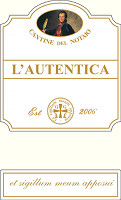
|
|
L'Autentica 2006 |
|
| Cantine del Notaio (Basilicata, Italy) | |
| Grapes: Moscato Bianco (70%), Malvasia Bianca (30%) | |
| Price: € 29.00 - 50cl | Score: |
| L'Autentica shows a brilliant amber yellow color and nuances of amber yellow, transparent. The nose reveals intense, clean, pleasing, refined and elegant aromas which start with hints of raisin, dried apricot and honey followed by aromas of dried fig, date, peach jam, candied fruits, citrus fruit peel, lychee, pear, vanilla, apple, lavender and nail polish. The mouth has excellent correspondence to the nose, a sweet and round attack, however balanced by alcohol, good body, intense flavors, pleasing crispness. The finish is very persistent with long flavors of raisin, dried apricot and lychee. L'Autentica ages for 14 months in barrique. | |
| Food Match: Hard and piquant cheese, Fruit tarts, Confectionery | |
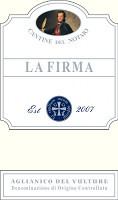
|
|
Aglianico del Vulture La Firma 2007 |
|
| Cantine del Notaio (Basilicata, Italy) | |
| Grapes: Aglianico | |
| Price: € 32.00 | Score: |
| Aglianico del Vulture La Firma shows an intense ruby red color and nuances of ruby red, little transparency. The nose reveals intense, clean, pleasing, refined and elegant aromas which start with hints of black cherry, blackberry and plum followed by aromas of violet, blueberry, raspberry, chocolate, mace, tobacco, pink pepper, vanilla and menthol. The mouth has excellent correspondence to the nose, a tannic attack and however balanced by alcohol, full body, intense flavors, pleasing roundness. The finish is very persistent with long flavors of black cherry, blackberry and plum. Aglianico del Vulture La Firma ages for 12 months in barrique. | |
| Food Match: Game, Roasted meat, Stewed and braised meat, Hard cheese | |
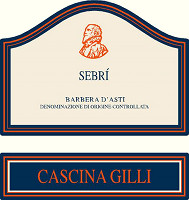
|
|
Barbera d'Asti Sebrì 2007 |
|
| Cascina Gilli (Piedmont, Italy) | |
| Grapes: Barbera | |
| Price: € 12.00 | Score: |
| Barbera d'Asti Sebrì shows a brilliant ruby red color and nuances of ruby red, moderate transparency. The nose denotes intense, clean, pleasing and refined aromas that start with hints of cherry, plum and blueberry followed by aromas of blackberry, violet, tobacco, hay, chocolate and vanilla. The mouth has good correspondence to the nose, a slightly tannic attack and pleasing crispness, however balanced by alcohol, good body, intense flavors, pleasing roundness. The finish is persistent with flavors of cherry, plum and blackberry. A part of Barbera d'Asti Sebrì ages in barrique for more than 12 months. | |
| Food Match: Roasted meat, Stewed and braised meat, Broiled meat and barbecue | |
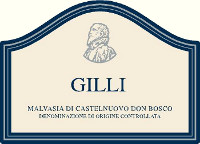
|
|
Malvasia di Castelnuovo Don Bosco 2009 |
|
| Cascina Gilli (Piedmont, Italy) | |
| Grapes: Malvasia di Schierano | |
| Price: € 8.00 | Score: |
| This Malvasia di Castelnuovo Don Bosco shows a pale ruby red color and nuances of cherry pink, transparent. The nose denotes intense, clean, pleasing and refined aromas which start with hints of grape, strawberry and raspberry followed by aromas of cherry, iris, cyclamen, blueberry and rose. The mouth has good correspondence to the nose, a sweet and crisp attack, however balanced by alcohol, light body, intense flavors, pleasing effervescence. The finish is persistent with flavors of grape, raspberry and strawberry. This Malvasia di Castelnuovo Don Bosco ferments in tank. | |
| Food Match: Cream desserts, Semifreddo, Fruit desserts | |
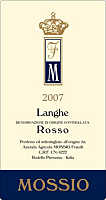
|
|
Langhe Rosso 2007 |
|
| Mossio (Piedmont, Italy) | |
| Grapes: Barbera (40%), Nebbiolo (40%), Dolcetto (20%) | |
| Price: € 15.00 | Score: |
| This Langhe Rosso shows an intense ruby red color and nuances of ruby red, little transparency. The nose denotes intense, clean, pleasing, refined and elegant aromas which start with hints of cherry, plum and violet followed by aromas of blueberry, blackberry, raspberry, vanilla, chocolate, tobacco, mace and menthol. The mouth has good correspondence to the nose, a tannic attack and however balanced by alcohol, good body, intense flavors, pleasing crispness. The finish is persistent with flavors of cherry, plum and blueberry. This Langhe Rosso ages for 12 months in cask followed by 2 months of aging in bottle. | |
| Food Match: Roasted meat, Braised and stewed meat, Hard cheese | |
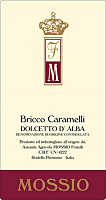
|
|
Dolcetto d'Alba Bricco Caramelli 2009 |
|
| Mossio (Piedmont, Italy) | |
| Grapes: Dolcetto | |
| Price: € 11.00 | Score: |
| Dolcetto d'Alba Bricco Caramelli shows a deep ruby red color and nuances of purple red, little transparency. The nose reveals intense, clean, pleasing, refined and elegant aromas which start with hints of black cherry, blackberry and plum followed by aromas of strawberry, cyclamen, geranium, anise, raspberry, peach, blueberry, almond and violet. The mouth has very good correspondence to the nose, a tannic attack and however balanced by alcohol, good body, intense flavors, agreeable. The finish is very persistent with long flavors of cherry, blackberry and plum. Dolcetto d'Alba Bricco Caramelli ages in steel tanks. | |
| Food Match: Cold cuts, Pasta with meat and mushrooms, Roasted white meat, Sauteed meat | |
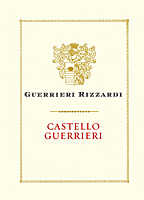
|
|
Castello Guerrieri Rosso 2007 |
|
| Guerrieri Rizzardi (Veneto, Italy) | |
| Grapes: Corvina (46%), Merlot (45%), Rondinella (9%) | |
| Price: € 14.90 | Score: |
| Castello Guerrieri Rosso shows a brilliant ruby red color and nuances of garnet red, moderate transparency. The nose denotes intense, clean, pleasing and refined aromas which start with hints of plum, blackberry and black cherry followed by aromas of blueberry, dried violet, raspberry, chocolate, vanilla and tobacco. The mouth has good correspondence to the nose, a tannic attack and however balanced by alcohol, good body, intense flavors, pleasing roundness. The finish is persistent with flavors of plum, blackberry and black cherry. Castello Guerrieri Rosso ages for 24 months in cask. | |
| Food Match: Roasted meat, Broiled meat and barbecue, Stewed meat, Hard cheese | |
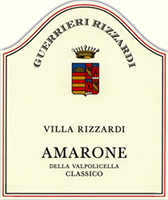
|
|
Amarone della Valpolicella Classico Villa Rizzardi 2005 |
|
| Guerrieri Rizzardi (Veneto, Italy) | |
| Grapes: Corvina, Rondinella, Corvinone, Barbera, Sangiovese | |
| Price: € 36.50 | Score: |
| Amarone della Valpolicella Classico Villa Rizzardi shows an intense ruby red color and nuances of garnet red, moderate transparency. The nose denotes intense, clean, pleasing and refined aromas that start with hints of black cherry, blackberry and plum followed by aromas of violet, blueberry, tobacco, vanilla, chocolate, mace and menthol. The mouth has good correspondence to the nose, a tannic attack and however balanced by alcohol, full body, intense flavors, pleasing roundness. The finish is persistent with flavors of blackberry, black cherry and plum. Amarone della Valpolicella Classico Villa Rizzardi ages for 12 months in barrique and for 24 months in cask. | |
| Food Match: Game, Roasted meat, Braised and stewed meat, Hard cheese | |

|
|
Bric Prac 2004 |
|
| La Fusina (Piedmont, Italy) | |
| Grapes: Muscat Blanc | |
| Price: € 13.00 - 50cl | Score: |
| Bric Prac shows a deep golden yellow color and nuances of golden yellow, transparent. The nose denotes intense, clean, pleasing and refined aromas which start with hints of raisin, dried apricot and almond followed by aromas of candied fruits, dried fig, honey, vanilla, citrus fruit peel, sage, peach jam and nail polish. The mouth has good correspondence to the nose, a sweet and round attack, however balanced by alcohol, good body, intense flavors, pleasing roundness. The finish is persistent with flavors of raisin, dried fig and dried apricot. Bric Prac ages in barrique for 12 months. | |
| Food Match: Confectionery, Dried fruit tarts | |
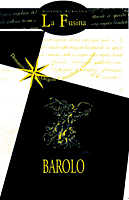
|
|
Barolo 2004 |
|
| La Fusina (Piedmont, Italy) | |
| Grapes: Nebbiolo | |
| Price: € 13.00 | Score: |
| This Barolo shows an intense ruby red color and nuances of garnet red, moderate transparency. The nose denotes intense, clean, pleasing and refined aromas which start with hints of cherry, plum and dried violet followed by aromas of blueberry, vanilla, tobacco, cocoa, cinnamon, leather, mace and menthol. The mouth has good correspondence to the nose, a tannic attack and however balanced by alcohol, full body, intense flavors, pleasing crispness. The finish is persistent with flavors of cherry, plum and blueberry. This Barolo ages for 24 months in cask followed by 12 months of aging in steel tanks and 8 months in bottle. | |
| Food Match: Game, Roasted meat, Braised and stewed meat, Hard cheese | |
|
||||||||
|
DiWineTaste Polls
|
| |||||||
Privacy Policy | |||||||


| Copyright © 2002-2024 Antonello Biancalana, DiWineTaste - All rights reserved |
| All rights reserved under international copyright conventions. No part of this publication and of this WEB site may be
reproduced or utilized in any form or by any means, electronic or mechanical, without permission in writing from DiWineTaste. |